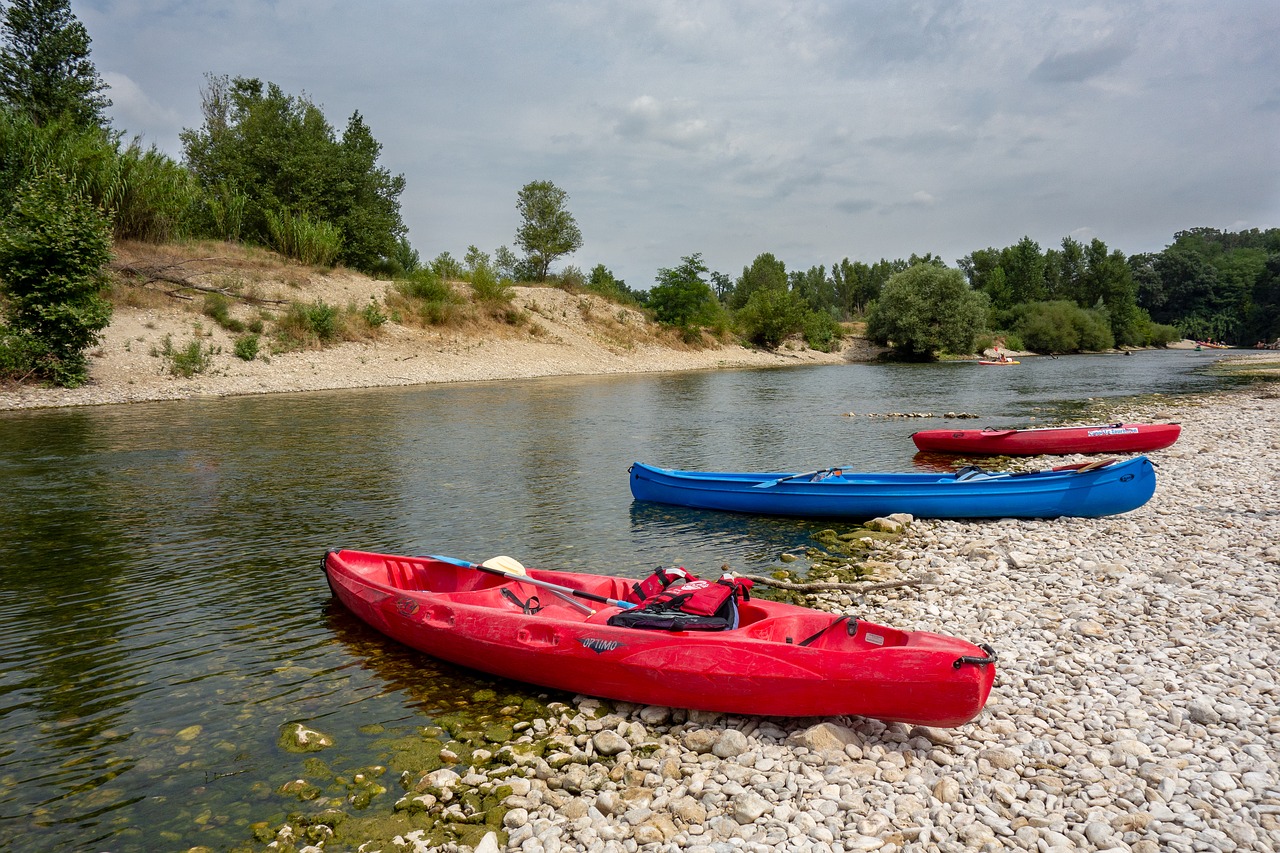Kayaking looks fairly intuitive, and most people quickly work out how to move their kayak around in roughly the right direction. But there’s a difference between making your boat move around and paddling your kayak efficiently.

This might seem like the most straightforward part of kayaking, but in fact, it’s one of the most common areas where people come unstuck. It’s the start of your kayaking journey, the step into the great blue beyond. Launching is an exciting moment, it means your hard work, your reading and your learning to get to this point is finally paying off; you get to go kayaking.
Don’t let your maiden voyage turn into a mishap right from the start. Equally, if you’ve stayed dry all day and had a great time on the water, you don’t want to end it with an accidental capsize.
Before we get too deep into what affects us, let’s look at how we get in and out of the kayak. There are three common ways to launch: from a beach in the water, from a high point like a pontoon or river bank, or by ‘seal launching’.
How to Launch a Kayak from a Beach
Beach launching is the most common way to launch a kayak onto calm, flat water.
Walk your kayak into the water until you are roughly ankle deep and your kayak is floating and pointing straight out from the shore.
If you’re launching onto a narrow river, you may be better pointing your boat alongside the river bank, but watch out for any obstacles on the bank.
If your kayak is sit-on-top, you may just be able to float it and sit into the seat and begin paddling.
If you paddle a closed cockpit kayak, step one foot either side of the kayak near the front of the cockpit.
If you have deck lines on your kayak, use them to secure your paddle. If you don’t, try to use your legs to hold it close for now, and don’t forget to grab it when your legs are in the boat.
Squat and place your hands on the sides of the cockpit, and sit yourself firmly in the seat. Lift your legs and place them into the kayak. Don’t forget to grab your paddle if you need to.
Get your legs set and shuffle yourself back in your seat until you’re firmly connected. If you’re wearing a spray skirt, pull it round the cockpit, making sure the tag is on the outside.
How to Land a Kayak on a Beach
Follow the same process, but in reverse.
Paddle towards the beach and stop when you can reach the floor comfortably with your hands. Secure your paddle and remove your spray skirt.
Bring your knees up towards your chest, and lift your feet over the side of the kayak, one at a time.
Place your hands on the sides of the cockpit and stand/lift yourself out of the boat.
Walk your kayak back onto the beach.
Launching a Kayak from Docks, River Banks, or Pontoons
If you have to launch from a pontoon or a higher river bank into deep water, you need to first place your kayak gently into the water, probably with the help of a friend, running parallel to the jeti/bank.
Sit yourself down on the dock and dangle a foot into the kayak to stop it drifting away. Place your paddle within reach of your kayak.
With both feet inside your kayak, place your hands on the dock and gently lower yourself into the boat until you’re securely on the seat. Slide your feet down to the foot pegs and shuffle yourself until comfortable. If you prefer, place on hand on the kayak and one on the dock for stability.
Keep yourself in reach of the dock as you pop your spray deck on, if you’re using one. Grab your paddle and head off on your adventure.
Landing a Kayak on a Dock, River Bank or Pontoon
Paddle up alongside the dock, come to a stop and pop your paddle up next to you. Keen it within reach, though, just in case you somehow drift away and need to paddle back in.
Hold the dock with one hand, release your spray skirt with the other, and bring your knees up towards your chest so your feet are just in front of your seat.
Twist your body to face the dock and place your other hand on the dock, too. Push with your legs and lift with your arms to climb up out of the kayak. Keep one foot in the boat to prevent it drifting away and kneel on the dock with your leading leg.
Spin and sit down, grab your boat and lift it out of the water. If you have a partner, get them to help you here.
Seal Launching a Kayak
Also known as shuffling, this technique takes you from dry land to the water without first getting your feet wet. This is a useful technique for launching onto rivers or into choppier seas, where you won’t have time for a slow launch before you have to paddle into the waves or start moving around the river.
- Place your boat as close to the water as is feasible, to minimise launch effort and environmental impact.
- Sit in your kayak and get yourself comfortable, connected, and get your spray skirt on.
- Grab your paddle and hip thrust your way into the water. This is much easier if you have a sloped entry.
- Remember to check the water depth. If you’re seal launching down a steep slope, you pick up a lot of speed and can go quite deep!
There are also environmental considerations here, including whether you’re doing any damage to the ground under your boat, or are likely to leave plastic behind by seal launching.
Launching a Kayak in Waves
Rough conditions can make launching and landing tricky, but not impossible. A combination of the seal launch and straight beach launch are useful here, as turning side on in the waves is a recipe for a capsize.
Sea waves generally come in sets, and you should try to coincide your launch with a smaller, less powerful set. Open water waves, caused by wind, generally have lulls too, and often weather has patterns. Try to find one of these lulls for your launch.
It’s easiest if you have a friend who can help you launch, keeping you stable and giving you a shunt to get you going. If you’re flying solo, or are the last person to launch, place your boat down with the nose just in the water, and climb in, get comfortable and put your spray skirt on. Make sure you have your paddle to hand.
As the waves wash in, they should float your kayak, either partially or completely. Use this to your advantage and shuffle/paddle your way out onto the water. Try to build power quickly to crash through the waves.
If you do get turned sideways, lean onto the wave and show your butt to the beach, this will help you surf back to shore where you can start again.
Landing a Kayak in Waves
Landing in waves can be equally tough. Time your approach with a smaller set of waves and control your speed so you don’t plough too far up the beach, especially if the beach is sharp and rocky, or you’re in a fibreglass kayak. Paddle backwards, against the waves, if necessary.
Once your boat stops in contact with the beach, exit quickly and keep hold of your boat and paddle so they aren’t washed away.
Again, this is easier with a friend to help you.
Launching and Landing a Kayak: Things to Be Aware of
Weather and Waves
As we’ve mentioned before, these things can wreak havoc with even the best laid plans. Plan your launch according to the prevailing conditions. If possible, launch into a more sheltered bay, or in the lee of an obstacle which gives you some shelter.
Equally, flow can be lumped in with these things. Watch out for downstream objects, as well as the flow affecting your launch.
Your Hull Shape
Some boats are more stable than others, that’s just a fact of kayaking. A flat hulled boat is usually more stable and much easier to launch in. If your boat has a v-shaped hull, watch out for it tipping as you sit into it, or especially if you plan to seal launch from a beach.
Seal launches catch people out in boats with flat hulls around the seating area, but sharp v-shapes at the bow and stern when these become the only part in contact with the water.
Don’t Sit on Your Spray Skirt
It’s easily done, but try not to sit on the back of your spray skirt when you’re launching. It will inhibit a fast launch and the shuffling around you need in order to get out may lead to a capsize.
Rudders and Skegs
Usually these are safely stowed when you launch, as you’ve just got your boat off your car. When landing, make sure to bring these up before you get into shallow water to avoid damaging them.
Keep your Paddle Handy
It’s easy to get washed off the beach or shore while trying to launch or land, so it’s worthwhile keeping your paddle close at hand just in case.
Don’t Start Launching Until You’re Ready to Go
Finally, just make sure everything is secured and loaded before you start your launching process. Make sure your PFD is on and fastened, and you have everything you need. You don’t want to be coming back once you’re out on the water.









